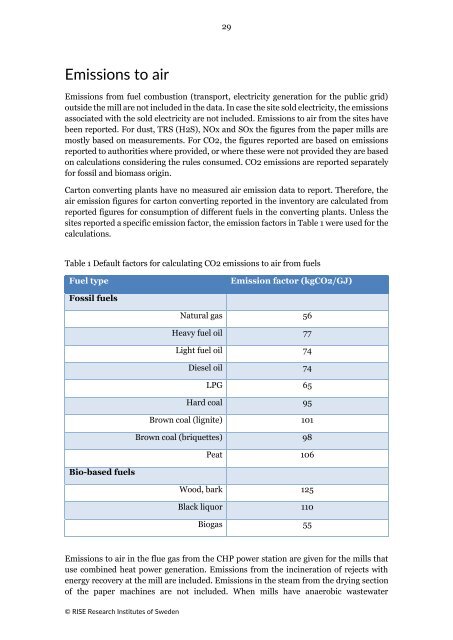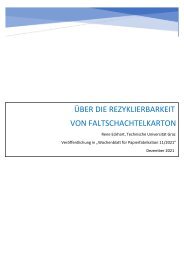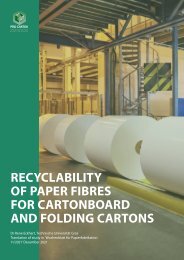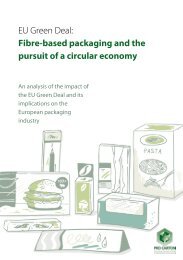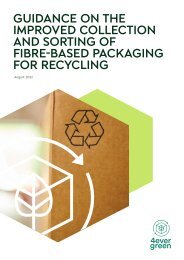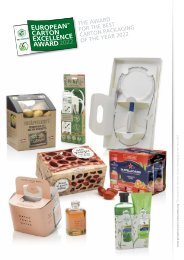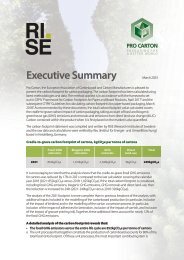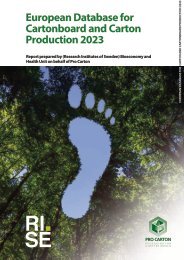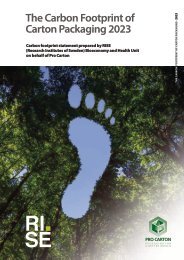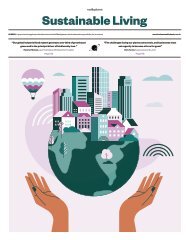European database for cartonboard and carton production, 2023
Create successful ePaper yourself
Turn your PDF publications into a flip-book with our unique Google optimized e-Paper software.
26<br />
Allocation of residues to paper grades when a mill produces more than one<br />
paper grade<br />
Data <strong>for</strong> material outputs are based on measurements. These have to be done because<br />
the mills have to pay <strong>for</strong> l<strong>and</strong>fill <strong>and</strong> incineration or get paid <strong>for</strong> residues that are reused<br />
or recycled, like lubricants, according to the weight. When of residues between products<br />
was required, this was done on the basis of causality wherever possible. Where this was<br />
not possible, allocation was made according to mass of the different papers produced.<br />
Energy input <strong>and</strong> output<br />
Fuel inputs to the sites are reported in GJ. The lower calorific heat values have been used<br />
to calculate GJ from m3 or tonnes of fuel. Fossil fuel <strong>and</strong> biomass fuel have been reported<br />
separately. The energy figures <strong>for</strong> the sites include both energy <strong>for</strong> process <strong>and</strong> energy<br />
<strong>for</strong> infrastructure. No attempts have been made to differentiate between these two types<br />
of energy usage because process energy dominates (98% or more <strong>for</strong> the <strong><strong>carton</strong>board</strong><br />
mills, although space heating can be a significant share of the thermal energy consumed<br />
at converting plants).<br />
Input of electricity into the sites is also reported. Electricity produced at the site itself is<br />
not reported. Some mills sell energy externally in the <strong>for</strong>m of electricity, steam or warm<br />
water. The <strong>production</strong> sites are treated as a black box in the <strong>database</strong>, giving data on<br />
inputs <strong>and</strong> outputs only. Because no in<strong>for</strong>mation is given about what happens within the<br />
box it is not possible to calculate an energy balance with the data in the <strong>database</strong>. Within<br />
this black box, energy is recovered through the burning of black liquor <strong>and</strong> bark from the<br />
wood coming in at <strong>production</strong> sites <strong>for</strong> primary fibre-based <strong><strong>carton</strong>board</strong> <strong>production</strong>. For<br />
some FBB <strong>and</strong> SUB/SBB mills, most of the energy used in the process comes from<br />
internal burning of the black liquor. This inherent energy is not reported as part of the<br />
fuel input in the gate-to-gate inventory, although it is reported separately in Table 3. The<br />
total energy input <strong>for</strong> the process <strong>for</strong> virgin <strong><strong>carton</strong>board</strong> <strong>production</strong> including the black<br />
liquor burning is around 12.5 GJ/tonne. The total energy input <strong>for</strong> the <strong>production</strong> of<br />
recycled <strong><strong>carton</strong>board</strong> is around 6.5 GJ/tonne. Combined heat power generation is<br />
applied at most of the <strong>production</strong> sites, but not always in the same way. The combined<br />
heat power generation can cover all or part of the steam consumption (Figure 6). When<br />
it covers only part of the steam consumption, then additional boilers also produce steam.<br />
The process always uses more heat (steam) than electricity. There<strong>for</strong>e, when the<br />
installation is designed to cover the whole steam consumption more electricity is<br />
generated than is needed <strong>for</strong> the process. The excess of electricity is sold to the public<br />
grid. There are two possible ways of treating this excess electricity in an LCA.<br />
a. The <strong>production</strong> of electricity is an integral part of the <strong><strong>carton</strong>board</strong> <strong>production</strong>: it would<br />
not be produced if the paper were not produced. Cartonboard is thus considered as the<br />
only “product” of the process. In an LCA this would mean that electricity generation <strong>for</strong><br />
the public grid is “saved” when an excess of electricity produced at a paper mill is sold to<br />
the public grid. Thus, environmental inputs <strong>and</strong> outputs are saved since combined heat<br />
power installation produces electricity with a higher efficiency than the public grid.<br />
b. Another possibility is to consider the paper <strong>and</strong> excess electricity as co-products.<br />
Cartonboard <strong>and</strong> electricity are then both “products” from the process. In an LCA this<br />
would require allocation of inputs <strong>and</strong> outputs to both products.<br />
© RISE Research Institutes of Sweden


